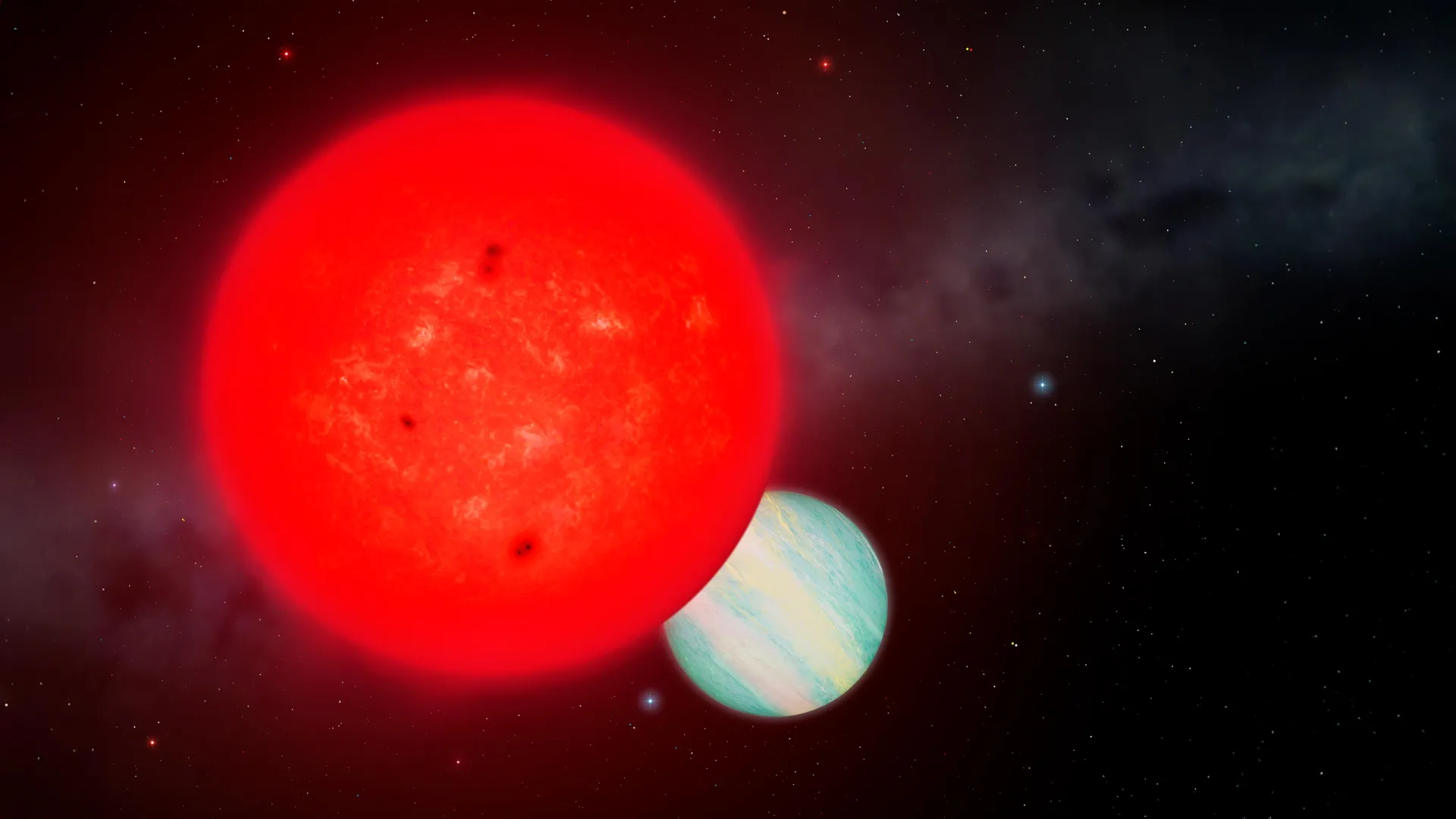How did a planet this big form around a star this small?
An international team of astronomers, including researchers from the University of Liège and collaborators in UK, Chile, the USA, and Europe, has discovered a giant planet orbiting the smallest known star to host such a companion.
- Date:
- August 26, 2025
- Source:
- University of Liège
- Summary:
- Astronomers have discovered a giant Saturn-sized planet orbiting TOI-6894, the smallest star ever known to host such a world. The finding overturns long-held theories suggesting that tiny, low-mass stars lack the material needed to form or keep giant planets.
- Share:

The host star, TOI-6894, is a red dwarf with only 20% the mass of the Sun, typical of the most common stars in our galaxy. Until now, such low-mass stars were not thought capable of forming or retaining giant planets. But as published recently in Nature Astronomy, the unmistakable signature of a giant planet -- TOI-6894b -- has been detected in orbit around this tiny star.
This exceptional system was first identified in data from NASA's Transiting Exoplanet Survey Satellite (TESS), as part of a large search for giant planets around small stars, led by Dr. Edward Bryant from UCL's Mullard Space Science Laboratory.
The planetary nature of the signal was then confirmed by an extensive ground-based observation campaign, involving several telescopes -- including those of the SPECULOOS and TRAPPIST projects, both led by the University of Liège.
Dr. Khalid Barkaoui, researcher on the SPECULOOS and TRAPPIST teams, oversaw these crucial follow-up observations. He explained: "The transit signal was unambiguous in our data. Our analysis ruled out all alternative explanations -- the only viable scenario was that this tiny star hosts a Saturn-sized planet with an orbital period of just over three days. Additional observations confirmed that its mass is about half that of Saturn. This is clearly a giant planet."
TOI-6894 is now the smallest star known to host a transiting giant planet, with a radius 40% smaller than that of any previous such host.
Prof. Jamila Chouquar, who was an astronomer at ULiege at the time of the discovery, added: "We previously believed that stars this small couldn't form or hold on to giant planets. But stars like TOI-6894 are the most common type in the Milky Way -- so our discovery suggests there may be far more giant planets out there than we thought."
A Challenge to Planet Formation Models
According to current planet formation models, giant planets are rare around small stars. This is because their protoplanetary disks -- the gas and dust reservoirs from which planets form -- are thought to lack the material needed to build massive cores and accrete thick gas envelopes.
Dr. Mathilde Timmermans, member of the SPECULOOS team and ULiege astronomer at the time of the discovery, noted: "The existence of TOI-6894b is hard to reconcile with existing models. None can fully explain how it formed. This shows that our understanding is incomplete, and underscores the need to find more such planets. That's exactly the goal of MANGO, a SPECULOOS sub-program led by myself and Dr. Georgina Dransfield at the University of Birmingham."
Prof. Michaël Gillon,Fund for Scientific Research -- FNRS Research Director at ULiege and head of the SPECULOOS and TRAPPIST programs, concluded: "This giant planet orbiting a tiny star reveals that planetary diversity in the galaxy is even greater than we imagined. Most of the targets observed by SPECULOOS and TRAPPIST are similar stars, or even smaller -- so we're well positioned to uncover more cosmic outliers in the years ahead."
Story Source:
Materials provided by University of Liège. Note: Content may be edited for style and length.
Journal Reference:
- Edward M. Bryant, Andrés Jordán, Joel D. Hartman, Daniel Bayliss, Elyar Sedaghati, Khalid Barkaoui, Jamila Chouqar, Francisco J. Pozuelos, Daniel P. Thorngren, Mathilde Timmermans, Jose Manuel Almenara, Igor V. Chilingarian, Karen A. Collins, Tianjun Gan, Steve B. Howell, Norio Narita, Enric Palle, Benjamin V. Rackham, Amaury H. M. J. Triaud, Gaspar Á. Bakos, Rafael Brahm, Melissa J. Hobson, Vincent Van Eylen, Pedro J. Amado, Luc Arnold, Xavier Bonfils, Artem Burdanov, Charles Cadieux, Douglas A. Caldwell, Victor Casanova, David Charbonneau, Catherine A. Clark, Kevin I. Collins, Tansu Daylan, Georgina Dransfield, Brice-Olivier Demory, Elsa Ducrot, Gareb Fernández-Rodríguez, Izuru Fukuda, Akihiko Fukui, Michaël Gillon, Rebecca Gore, Matthew J. Hooton, Kai Ikuta, Emmanuel Jehin, Jon M. Jenkins, Alan M. Levine, Colin Littlefield, Felipe Murgas, Kendra Nguyen, Hannu Parviainen, Didier Queloz, S. Seager, Daniel Sebastian, Gregor Srdoc, R. Vanderspek, Joshua N. Winn, Julien de Wit, Sebastián Zúñiga-Fernández. A transiting giant planet in orbit around a 0.2-solar-mass host star. Nature Astronomy, 2025; 9 (7): 1031 DOI: 10.1038/s41550-025-02552-4
Cite This Page: